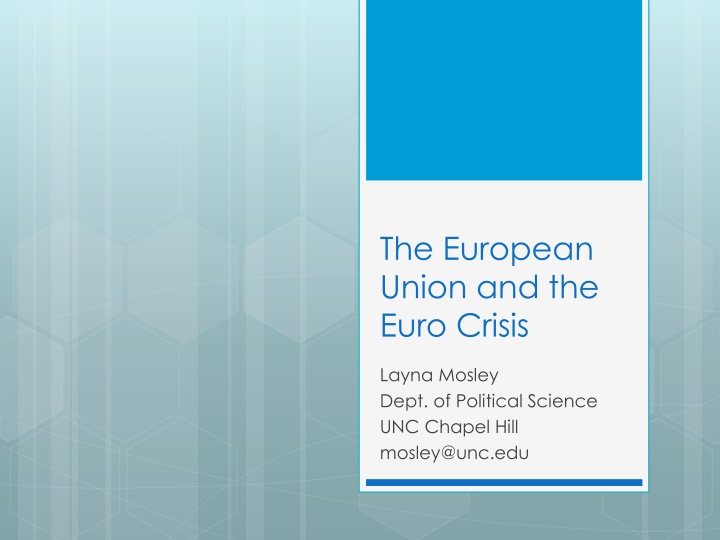The European Union and the Euro Crisis Overview
Delve into the complexities of the Economic and Monetary Union, the challenges faced during the Euro crisis, and the historical background of the Eurozone. Understand the criteria for Eurozone membership and the impact of the Euro as a reserve currency on the global market.
Download Presentation

Please find below an Image/Link to download the presentation.
The content on the website is provided AS IS for your information and personal use only. It may not be sold, licensed, or shared on other websites without obtaining consent from the author.If you encounter any issues during the download, it is possible that the publisher has removed the file from their server.
You are allowed to download the files provided on this website for personal or commercial use, subject to the condition that they are used lawfully. All files are the property of their respective owners.
The content on the website is provided AS IS for your information and personal use only. It may not be sold, licensed, or shared on other websites without obtaining consent from the author.
E N D
Presentation Transcript
The European Union and the Euro Crisis Layna Mosley Dept. of Political Science UNC Chapel Hill mosley@unc.edu
Cyprus, March 2013 Cyprus joined EU in 2004, and the eurozone in 2008
Outline The making of Economic and Monetary Union (EMU) The 2000s: Market Enthusiasm 2009-2013: Crisis and Austerity
The making of EMU Werner Report, 1970 Coordination of exchange rates European Monetary System & ERM, 1979- 1999 Maastricht Treaty, 1992 Economic and Monetary Union (EMU) Economic as well as political motivations Shared currency (euro) European Central Bank to determine monetary policy (interest rates) Criteria for membership Inflation, interest rate convergence Fiscal deficits (<3%/GDP), government debt (<60%/GDP, or declining toward that)
The making of EMU 1998: determination of which countries meet the convergence criteria Opt outs: Denmark, Sweden, UK 1999: the Euro comes into existence, with 11 members Post-EMU fiscal discipline: the Stability and Growth Pact Monitors deficit and debt on an annual basis 2001: Greece joins the eurozone 2002: physical currency begins to circulate 2007: Slovenia joins 2008: Malta and Cyprus join 2009: Slovakia joins 2011: Estonia joins
The first decade: market enthusiasm 25 Interest Rates on Benchmark Government Bonds Australia Austria Belgium 20 Canada Czech Republic Denmark 15 Finland France Germany 10 Eurozone: Interest rate convergence, despite differences in economic fundamentals Greece Hungary Iceland 5 Ireland Italy Japan Korea 0 1995 1996 1997 1998 1999 2000 2001 2002 2003 2004 2005 2006 2007 2008 2009 2010 2011 Netherlands
The Euro The share of the euro as a reserve currency increased from 17.9% globally in 1999 to 26.5% in 2008 2011: 24.9% US dollar 2011: 61.8%
The first decade: market enthusiasm Violations of the Stability and Growth Pact occur The earliest violators (2002-2005) include Greece and Portugal But also France and Germany Large EU members don t face Excessive Deficit Procedures But investors don t seem bothered by violations. Why? Assumption that bailouts would occur? Timeline of the crisis: http://www.bbc.co.uk/news/business-13856580
Crisis and Austerity (I) Collapse of real estate markets in Ireland and Spain. Weakly regulated banks are bailed out. Southern European economies have difficulty competing on world markets But can t devalue their currency. And the ECB won t lower interest rates, as not all eurozone countries face slowdowns. Budget deficits widen as eurozone economies face rising unemployment.
Crisis and Austerity (II) Fiscal news gets worse 2009: EU orders France, Greece, Ireland and Spain to reduce deficits Severe irregularities in Greek accounting; deficit revised from 3.7% to 12.7% of GDP Downgrades of sovereign debt Investors no longer assume that EU member government debt is free from default risk December 2009: ratings downgrades for Greek debt which is 113% of GDP January 2012: downgrades of France and eight other eurozone governments Increases in interest rates on gov t bonds August 2011: ECB begins buying Italian and Spanish government bonds, to try to bring down borrowing costs.
Crisis and Austerity (III) Austerity Greece announces numerous rounds of austerity measures, beginning in Feb. 2010 Ireland: November 2010, toughest budget in history. Bailout packages May 2010, March 2012: EU/IMF bailout packages for Greece Nov. 2010: bailout for Ireland February 2011: European Stability Mechanism, a permanent bailout fund, established. May 2011: bailout for Portugal March 2013: bailout for Cyprus?
Why Bailouts? Bailouts generate backlash in bailed-out countries as well as elsewhere in the EU. Require agreement with European Commission, ECB and Int l Monetary Fund Concerns about stability of private banks in PIIGs and elsewhere in the EU In the peripheral countries, struggling banks have cut credit, worsening the recession. Worries about the euro, both in terms of its global image and in terms of keeping countries in. Stronger fiscal rules agreed to in January 2012.
Caveats The entire Euro area faces economic challenges: Growth rate of 0.4% (2012), -0.2% (2013) Unemployment rate of 11.2% (2012), 11.5% (2013) US in 2012: growth 2.2%, unemployment 8.2% But not all crises were created equally: Greece: large fiscal deficits, high debt levels, tax evasion, low savings rate Portugal: low savings rate, fiscal deficits Spain: property market bubble, persistent unemployment. Ireland: pre-crisis debt/GDP of 25%. Property market bubble, banking crisis, bank bailout. Italy: better savings rate and external balance than the others, but large in terms of absolute amount of debt.
Government Bond Rates, 2005-2011 18 16 Austria Belgium France Germany Greece Ireland Italy Netherlands Portugal Spain United Kingdom United States 14 12 10 8 6 4 2 0 2005 2006 2007 2008 2009 2010 2011
WEO Oct 2013: http://www.imf.org/external/pubs/ft/weo/ 2012/02/pdf/text.pdf
With the crisis, a renewed attention to default risk, and to differences across countries. 4.5 4 3.5 3 Reward for EMU disappears, or at least is reduced. 2.5 2 1.5 1 Chart: variance in government bond rates among OECD nations. 0.5 0
More generally, developed nations are more indebted than their emerging market counterparts. Source: Bank for International Settlements, 2012 Annual Report
Average Time to Maturity of Government Debt, 2010 16 14 12 10 8 6 4 2 0 Australia Austria Canada Denmark Estonia Finland France Germany Hungary Ireland Italy Netherlands New Zealand Spain United Kingdom United States























